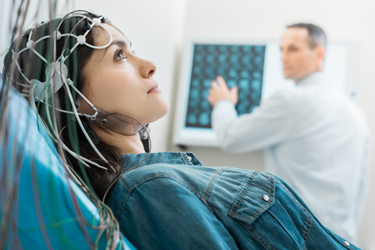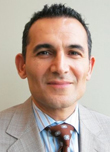EEG Technologies Grow Beyond Traditional Diagnostics
By Ali Davies and Kamran Zamanian, Ph.D., iData Research

While electroencephalography (EEG) technology has long been a valuable diagnostic tool in the context of non-urgent care, its well-established status in healthcare facilities has driven slow but steady growth in the U.S. market. However, a variety of nontraditional EEG methods and technologies popularized in recent years have created a buzz in this once predictable market. Within the last few years, the keen eye of medical researchers has turned to the possibilities of rapid response EEG and the place of EEG within a larger suite of intraoperative neurophysiological monitoring strategies. These previously unexplored options are now being integrated into healthcare facilities across the U.S., stirring up the market for manufacturers and healthcare providers alike.
Rapid EEG For Diagnosis
For EEG to be a feasible critical care diagnostic tool, one primary hurdle must be overcome: time to EEG. Beyond the time required to place EEG electrodes on the patient’s scalp, healthcare providers must also requisition the appropriate resources for the procedure, such as an available monitor and a neurologist to review the data. A study1 of EEG logistics under these circumstances determined that the median time to EEG under conventional circumstances was nearly 4 hours.
Until recently, past attempts to reduce the time to EEG have largely consisted of finding ways to facilitate the placement of electrodes. Devices such as electrode caps have been available since the 1970s and have remained fairly popular as an efficiency tool in the intervening years. However, these caps are significantly more expensive than purchasing simple electrodes in bulk and, therefore, healthcare providers often must choose between efficiency and budget.
Many modern manufacturers striving to make their EEG devices faster choose to implement a headset component, perhaps inspired by the foundation laid by the EEG cap. However, EEG headsets are paired exclusively with a display device and therefore are able to be further specialized. For example, headsets and displays are often connected via Bluetooth, thus reducing the time spent setting up electrode cables and plugging in monitors.
The most recent development in facilitating the use of EEG for rapid diagnostic purposes is the reduced montage. In 2022, a study2 found that a down-sampled montage of eight electrodes slightly reduced the sensitivity to detect seizure patterns and had no functional reduction in specificity. These judgements were determined through comparison to the standard international 10-20 montage (21 electrodes) and demonstrate that the reduced montage approach bears significant potential. It is, however, acknowledged that a full montage of 16 to 21 electrodes is still the most effective approach when diagnosis is less time-dependent.
Growth In The Rapid EEG Market
The dedicated rapid EEG market is very young and thus is capable of incredible growth. The exponential growth observed in the last few years and projected to the end of the decade is not only primarily driven by expansion in unit sales but also influenced by a gradual increase in the average selling price of each monitor. Such a phenomenon is often seen in young markets like these, given the limited number of available products to compete for consumer attention. From 2023 to 2030, the projected compound annual growth rate (CAGR) for the entire rapid EEG market is more than 5%.

As of November 2023, there are fewer than five significant competitors with products in this market segment, only one of which is present in any other EEG market. This sparse landscape will likely become further populated in the coming years as other competitors enter the market.
EEG In The Operating Room
In the setting of an operating room (OR), the uses and goals of EEG are vastly different. While speed can still be an asset, these circumstances usually involve continuous monitoring over extended periods of time. While EEG monitoring is a well-established technology for sleep studies, it has begun to be used to monitor the degree to which a patient’s central nervous system is suppressed by general anesthetic. Modern depth of anesthesia EEG monitors frequently utilize the bispectral index (BIS) to present healthcare practitioners with a single value alongside real-time EEG waveforms.
Yet another form of EEG monitoring is within the context of intraoperative neurophysiological monitoring (IONM). IONM refers to a wide variety of techniques used to monitor the function of a patient’s brain, brainstem, spinal cord, and nerves during surgery. EEG monitoring is particularly valuable when conducting procedures such as carotid endarterectomies, cerebral aneurysm clippings, and any surgeries addressing epilepsy.3 While it is very possible to carry out IONM using multiple monitors in parallel, this process is eased by the recent availability of dedicated IONM machines. These machines offer many advantages, including effective use of limited OR space and freeing up individual machines for other patients.
The Depth Of Anesthesia EEG Market
The depth of anesthesia EEG market is far older and far larger than the rapid EEG market. It is, however, also experiencing a rapid degree of growth, particularly in OEM modules. The CAGR for 2023 to 2030 is nearly 5%, and this market segment is expected to overtake the stand-alone module segment shortly after 2030. This market is currently in a near monopoly maintained by both the capital and disposable segments. This state is assisted by the fact that there are fewer than five significant competitors in this market.

The IONM market, on the other hand, is still in early stages of growth. The recent clinical research conducted in this area corresponds to an uptick in adoption of these techniques and, thus, increases in the market. This particular market is dominated by IONM machines and not the corresponding electrodes, an indicator that the capital segment is not yet saturated and has significant room to grow.
Closing Thoughts
The overall EEG market is in a state of flux, largely due to the additions of rapid EEG, depth of anesthesia, and IONM machines. While diagnostic EEG monitoring devices and consumables currently represent the majority of the total market value, any projection of the future cannot be accurate without considering the increasing influence of non-conventional EEG uses.
References
- https://www.ncbi.nlm.nih.gov/pmc/articles/PMC7735649/
- https://www.nature.com/articles/s41598-022-08628-9
- https://www.ncbi.nlm.nih.gov/books/NBK563203/
 About the Authors:
About the Authors:
Ali Davies is a research analyst at iData Research and works on research projects regarding the medical device industry, publishing the Patient Monitoring Equipment report series.
 Kamran Zamanian, Ph.D., is CEO and founding partner of iData Research. He has spent over 20 years working in the market research industry with a dedication to the study of medical devices used in the health of patients all over the globe.
Kamran Zamanian, Ph.D., is CEO and founding partner of iData Research. He has spent over 20 years working in the market research industry with a dedication to the study of medical devices used in the health of patients all over the globe.
